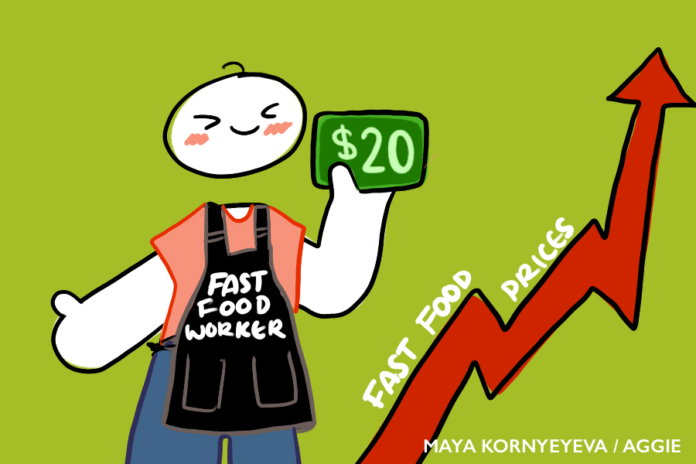What does this change mean for both customers and employees?
By MAYA KORNYEYEVA — mkornyeyeva@ucdavis.edu
As of April 1, 2024, all fast food workers in California received a significant minimum wage increase, with a base pay of $20 per hour. AB1228, the law that permits this change, was signed into effect by California Governor Gavin Newsom in September of last year. This granted fast food workers an hourly pay increase that, for some, was almost 25% more than they were paid previously.
While employees celebrate the fourth week of the new wage boost, customers and managers are frowning. What does $20 an hour actually mean for the future of the fast food industry?
For one, half a million fast food workers employed in restaurant chains like Starbucks, McDonalds and Jack in the Box — which all have over 60 locations to qualify AB1228’s requirements — are benefitting from the extra money in their paycheck. As a Starbucks barista, the new minimum wage has given me some financial wiggle room and a chance to work fewer hours to support myself. Employees seem to be breathing a sigh of relief; for those whose hourly pay jumped from $16 to $20, like me, $4 extra seems enormous.
On the other hand, franchise owners and customers are actively feeling some added pressure caused by AB1228. Some businesses are forced to cut worker and store hours due to lack of funding or raise product prices by a margin of 5% (and even 10%), a change that is being felt by many customers. Fast food, generally known as an affordable option, may see an increase that deters an entire class of customers that previously relied on the accessible prices.
It is important to note, however, that there are many ways for fast food companies to accommodate this new change while keeping profits up and customers coming back: a negative outlook on this new legislation is much too early to reflect the actual effects of AB1228. Rather than raising prices, companies can focus on leveraging hours, scheduling accordingly and introducing new products and promotional materials to maintain customers.
With this in mind, as a fast food worker with some inherent bias, I believe that this wage increase is essential for securing a close-to-liveable wage for workers and ensuring that companies aren’t exploiting the labor of demographic groups usually employed in the fast food industry — such as women, students, migrants and semi-skilled workers.
The previous minimum wage of $16 requires workers to dedicate themselves to a full-time job to afford basic necessities. Even then, a 40-hour week on a $16 wage is difficult to survive on, especially with the inflation we are currently experiencing and the instability of prices post-pandemic.
“Cheap and disposable food” that is often associated with the fast food industry shouldn’t extend to how we perceive laborers working in fast food. Even though a fast food job doesn’t require a college degree or a Ph.D., fast food workers go through extensive training to be specialized in their area of work — dealing with the social side of customer relations as well as the economic side of managing sales, counting inventory and calculating profit margins. The widespread outrage over the $20 minimum wage indicates that we, as a culture, have been subconsciously associating fast food work with cheap, invaluable labor.
This mentality of “disposability” — treating fast food jobs as a position that merely serves as a stepping stone to a higher, better paying specialized position — is a dangerous mindset that alienates the thousands of people who aren’t able to get a degree and therefore, are unable to pursue “better” jobs. These individuals are forced to work long hours and multiple jobs to support themselves. They often perform more complex manual labor than those in corporate positions.
A $20 minimum wage is the first step to ensuring that fast-food employees are compensated for their physically challenging work, and have a safety net protecting them from falling into poverty. Seeing as prices for goods and services are currently trending upwards, this minimum wage increase is both necessary and inevitable. Paying an extra 50 cents for your coffee at Starbucks is a small cost to ensure that workers whose income only comes from their fast food jobs are getting paid adequately and fairly.
Written by: Maya Kornyeyeva — mkornyeyeva@ucdavis.edu
Disclaimer: The views and opinions expressed by individual columnists belong to the columnists alone and do not necessarily indicate the views and opinions held by The California Aggie.




